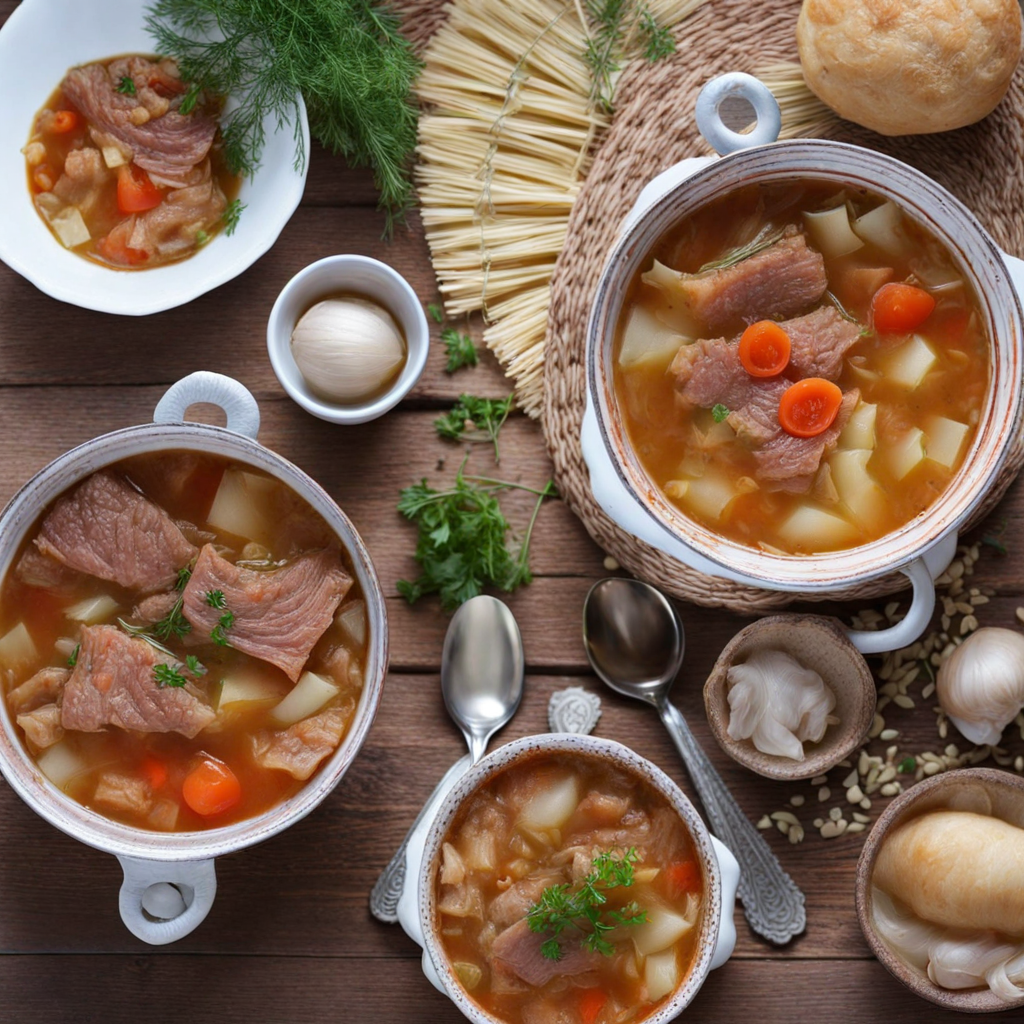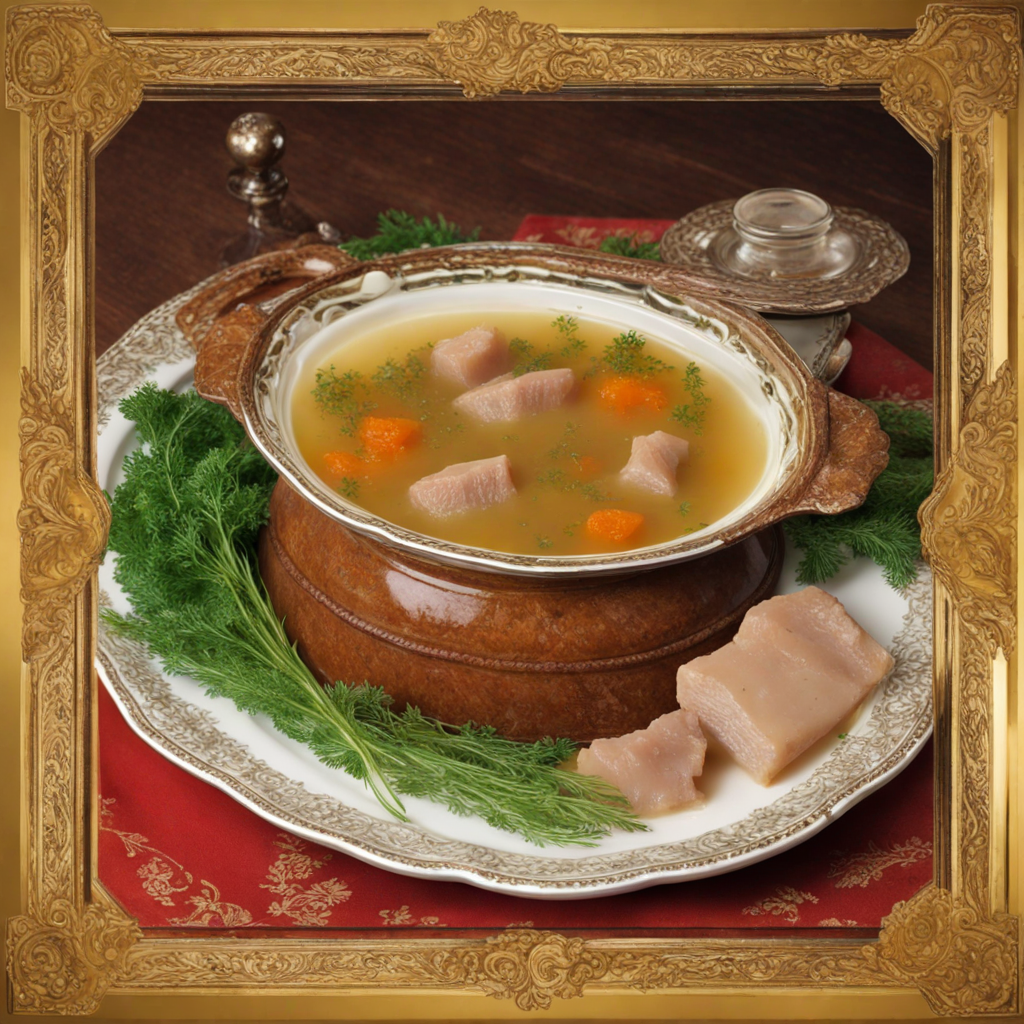Shchi
Shchi is a traditional Russian soup that embodies the rich culinary heritage of the country. Its primary ingredient is cabbage, which provides a hearty base and a distinctive tangy flavor. The soup often incorporates a variety of other vegetables such as carrots, potatoes, and onions, all simmered together to create a comforting and warming dish. Depending on regional variations and personal preferences, Shchi can also include meat, typically beef or pork, which adds depth and a savory richness to the broth. For those seeking a vegetarian option, Shchi can easily be prepared without meat, relying solely on the robust flavors of the vegetables and herbs. One of the defining characteristics of Shchi is its versatility; the dish can be enjoyed in many forms—be it a lighter, brothy version or a denser, more stew-like consistency. The addition of sour cream as a topping is a common practice, providing a creamy contrast to the soup's acidity. Fresh dill or parsley is often sprinkled on top for an aromatic finish, enhancing the overall flavor profile. This delightful combination of textures and flavors makes Shchi not only a staple in Russian households but also a beloved comfort food that warms the soul. Shchi is often served with a side of rye bread, which complements the soup perfectly and adds another layer of traditional Russian cuisine. The dish is particularly popular during the colder months, offering a nourishing and satisfying meal that reflects the spirit of Russian hospitality. As you delve into the world of Shchi, you'll discover not just a soup, but a cultural experience that speaks to the heart of Russian cooking and the importance of sharing food with loved ones.
How It Became This Dish
The Story of Щи: A Journey Through Russian Culinary Heritage #### Origins and Historical Context Щи, pronounced "shchi," is a traditional Russian soup that embodies the essence of Russian culinary culture. Its roots can be traced back to the early Slavic tribes, where simple ingredients were transformed into nourishing meals that sustained the population through harsh winters. The word "щи" is derived from the Old East Slavic "щь," which means "cabbage." Cabbage, a staple in Slavic diets, forms the foundation of this iconic dish. Historically, the soup evolved alongside the agricultural practices of the region. Cabbage, turnips, and other root vegetables were among the few crops that could withstand the bitter cold, making them vital to the diet of the Slavic people. Archaeological discoveries show that fermented foods, including cabbage, were consumed as far back as the 9th century. The practice of fermentation not only allowed for the preservation of food but also enhanced its nutritional value. #### Cultural Significance Щи is more than just a dish; it is a symbol of Russian hospitality and community. It is often associated with family gatherings, celebrations, and the warmth of home cooking. In Russia, it is common to serve щи as part of a meal during significant events, such as weddings, holidays, and communal feasts. The soup is a staple of everyday life, representing sustenance for the working-class, while also holding a place of honor at festive tables. In addition to its nutritional value, щи carries significant cultural symbolism. It is often seen as a comfort food, a dish that evokes memories of home and family. The preparation of щи can vary from family to family, leading to a rich tapestry of regional variations. Each version tells a story, incorporating local ingredients and cooking styles, reflecting the diversity of Russian culture. #### Development Through the Ages The evolution of щи reflects broader changes in Russian society and cuisine. In the 10th century, when the influence of Byzantine culinary practices began to permeate Russian kitchens, щи started to incorporate more spices and ingredients, such as meat and fish. The introduction of new vegetables, including potatoes and carrots, in the 18th century further diversified the soup's flavor profile. Throughout the centuries, the dish adapted to the availability of ingredients, the climate, and social changes. For instance, during the Soviet era, when food scarcity was common, щи became a symbol of resilience. The use of cabbages, potatoes, and whatever other vegetables were available highlighted the resourcefulness of the Russian people. The soup could be made with meat or served as a vegetarian option, making it versatile for various circumstances. In the late 19th and early 20th centuries, as the Russian Empire expanded and embraced Western influences, щи began to see gourmet interpretations. Chefs began to experiment with the soup, adding elements like cream, various herbs, and even gourmet meats. The rise of fine dining in urban centers such as St. Petersburg and Moscow led to an increased appreciation for traditional dishes, including щи, which gained recognition as a dish worthy of the finest tables. #### Regional Variations Щи is not a monolithic dish; its variations reflect the vast geography and cultural diversity of Russia. In central Russia, you might find traditional "white щи," made with fresh cabbage, while in Siberia, the "green щи" is popular, utilizing sorrel or nettles for a distinct flavor. In the Far East, seafood versions have emerged, highlighting the region's access to fresh fish. One notable variant is "Щи из квашеной капусты" (shchi iz kvashenoy kapusty), or sour cabbage soup. This particular version uses fermented cabbage, lending a tangy flavor that is particularly popular in winter months. The soup is hearty and provides a warm, comforting meal during the frigid Russian winters. Other regional adaptations include the addition of mushrooms, grains, or even berries, showcasing the local ingredients available to home cooks. Each version tells a unique story about the people and the environment from which it originates. #### Modern-Day щи Today, щи continues to be a beloved dish in Russia and among the Russian diaspora worldwide. It is often served in homes, restaurants, and during communal gatherings, still holding its place as a symbol of warmth and hospitality. Contemporary chefs are reviving traditional cooking methods while incorporating modern culinary techniques, ensuring that щи maintains its relevance in today's culinary landscape. The resurgence of interest in home cooking during the COVID-19 pandemic has also led to a revival of traditional dishes like щи. Many families took to the kitchen to recreate recipes passed down through generations, reinforcing the soup's role as a comfort food during challenging times. Moreover, the globalization of cuisine has led to an increasing appreciation for Russian food, with restaurants around the world showcasing traditional dishes. Chefs are now experimenting with flavors and techniques, introducing щи to a broader audience while honoring its rich history. #### Conclusion Щи is a dish steeped in history, culture, and tradition. From its humble beginnings as a sustenance for early Slavic tribes to its status as a symbol of Russian hospitality and resilience, щи has evolved over centuries, adapting to the changing landscape of Russian society. Each bowl of щи tells a story of community, family, and the enduring spirit of the Russian people. As this beloved soup continues to find its place in modern kitchens, it remains a testament to the rich culinary heritage of Russia—a delicious link between the past and present.
You may like
Discover local flavors from Russia







